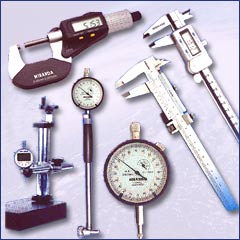Difference between revisions of "Measuring Instruments"
(Created page with "Category:Measuring, Calibration{{Knoppen}} <noinclude><!------------------------------------------------ * READ THIS FIRST * Only edit this page if you can improve the cont...") |
|||
| (One intermediate revision by one other user not shown) | |||
| Line 7: | Line 7: | ||
* Please start editing this page after the /noinclude | * Please start editing this page after the /noinclude | ||
* -------------------------------------------------></noinclude> | * -------------------------------------------------></noinclude> | ||
[[File:Measuring instruments.jpg|thumb|right|Measuring Instruments]] | |||
In the physical sciences, quality assurance, and engineering, measurement is the activity of obtaining and comparing physical quantities of real-world objects and events. Established standard objects and events are used as units, and the process of measurement gives a number relating the item under study and the referenced unit of measurement. '''Measuring Instruments''', and formal test methods which define the instrument's use, are the means by which these relations of numbers are obtained. All measuring instruments are subject to varying degrees of instrument error and measurement uncertainty. | |||
Scientists, engineers and other humans use a vast range of instruments to perform their measurements. These instruments may range from simple objects such as rulers and stopwatches to electron microscopes and particle accelerators. Virtual instrumentation is widely used in the development of modern measuring instruments. | |||
Time-points in the past can be measured with respect to the present of an observer. Time-points in the future can be fixed. But there seems to exist no device that can set time to a predetermined value, like it is possible with other physical quantities . The time-point called present seems to move in one direction only, the future. Entropy production and cause-and-effect observations of events correlate to this observation. | |||
Latest revision as of 09:54, 4 January 2013
In the physical sciences, quality assurance, and engineering, measurement is the activity of obtaining and comparing physical quantities of real-world objects and events. Established standard objects and events are used as units, and the process of measurement gives a number relating the item under study and the referenced unit of measurement. Measuring Instruments, and formal test methods which define the instrument's use, are the means by which these relations of numbers are obtained. All measuring instruments are subject to varying degrees of instrument error and measurement uncertainty.
Scientists, engineers and other humans use a vast range of instruments to perform their measurements. These instruments may range from simple objects such as rulers and stopwatches to electron microscopes and particle accelerators. Virtual instrumentation is widely used in the development of modern measuring instruments.
Time-points in the past can be measured with respect to the present of an observer. Time-points in the future can be fixed. But there seems to exist no device that can set time to a predetermined value, like it is possible with other physical quantities . The time-point called present seems to move in one direction only, the future. Entropy production and cause-and-effect observations of events correlate to this observation.
